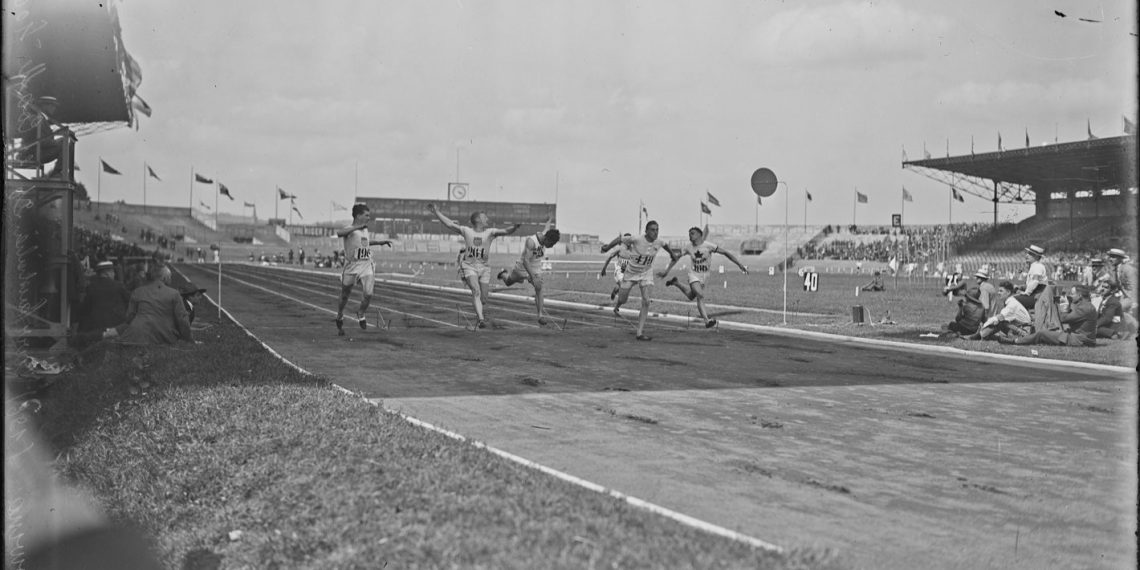Paris 1924 recalled – Charley Paddock’s leap of faith.
RelatedPosts
It was easy with the high jump. Dick Fosbury invented the Fosbury Flop and won the 1968 Olympic title, clearing the bar backward – or, as any other high jumper of that era would have said, the wrong way round.
But then, perhaps not any other high jumper. As by that time, a young Canadian named Debbie Brill, who would go on to win two Commonwealth titles, was independently developing a similar technique in which she went over the bar face upwards…
So – not so incredibly easy.
Anyway – let’s transpose that flying athlete thing to the track.
Eight years ago, I was in a damp and not entirely full stadium at the Rio 2016 Olympics and heard the crowd sound during the women’s 400-meter shift from excited to confounded.
The alteration in tone had occurred during an all-action finish in which 22-year-old Shaunae Miller of The Bahamas, under remorseless pressure from US runner Allyson Felix, had either collapsed or dived over the line and hit the deck hard.
My first thought was that Miller had run out of gas and blown it. I was wrong. She had claimed gold in 49.44sec, with Felix, who finished in traditional fashion, having to settle for silver in 49.51.
This was perhaps the most famous example of diving in an athletics track event.
But then – maybe it wasn’t a dive. Some years afterward, Britain’s Sydney 2000 women’s 400m bronze medallist Katharine Merry told me she thought Miller had indeed simply run out of gas and crumpled. Miller – nowadays Mrs. Miller-Uibo, proud parent of one son with Estonian decathlete Maicel Uibo – has said so herself.
A year later, a similar thing happened to her in the world 400m final in London, where she crumpled again at the finish, losing what had looked to be another global title and eventually finishing fourth.
So – not so definitely a diver.
There have, of course, been very definite divers. At the Beijing 2008 Games, American 400m runner David Neville earned the bronze medal by flinging himself across the line.
A couple of hours before Miller won in Rio, 24-year-old Brazilian hurdler Joao Vitor de Oliveira reached the semi-finals of the 110m hurdles with a proper Superman effort.
More recently, in 2019, footage went viral of the men’s 400 meters hurdles final at the Southeastern Conference Track & Field Championships in the United States, which concluded with the improbably named Infinite Tucker beating a Texas A&M University team-mate to the line with a full-on, Superman-style effort.
Moving away from the dive/no dive debate, however, we can look further back into athletics history to discern the man who was, surely, the originator of the “look, no legs” track finish – Charley Paddock.
By the time he got to the 1920 Olympics in Antwerp, Paddock had already earned a photographer-pleasing reputation for his flying leaps over the line in sprint races..
In the 100 meters at those Games, his trick worked a treat as he flew to victory, eyes skywards, arms outwards, earning gold in a time of 10.8sec, beating his US team-mate Morris Kirksey by 0.1sec.
Recalling his triumph in his 1932 autobiography The Fastest Human – Paddock was a well-established journalist and short story writer in Pasadena in his early career – he wrote: “I drove my spikes into the soft cinders and felt my foot give way as I sprang forward to a final jump for the tape…
“There was nothing more I could do. My eyes closed as my chest hit the string, and when I opened them, my feet were on the ground again, and I was yards ahead of the field…my greatest dream had come true, and I was thrilled about the greatest moment I felt I should ever know.”
In the 200m, however, the same effort had a silver rather than a golden reward as team-mate Allen Woodring caught him on the line.
Four years later, Paddock defended his title at the Paris Olympics but had to settle for fifth place.
In his sublime work The Complete Book of the Olympics, David Wallechinsky writes how Paddock had dined the night before the 200m semi-finals and finals with his film actor friend Douglas Fairbanks, actress Mary Pickford, and French singer Maurice Chevalier.
Paddock – who went on to appear in a 1926 film called The Campus Flirt alongside Paramount starlet Bebe Daniels – was convinced he was past his best and with no prospect of success. Pickford reportedly told him – “If you believe in yourself, you will win tomorrow.”
It got him back onto the podium, at least as he won his semi-final easily and led in the final before being caught on the line by another US sprinter and writer, Jackson Scholz, pulling a ligament in his thigh and making his trademark leap.
Paddock, who had served as a lieutenant during the First World War, was commissioned as a Marine Officer in 1942 and died the following year in a plane crash in Alaska while accompanying Major General William P Upshur, Commanding Officer in the Pacific.
He left a wife, a son, and a daughter. And a never-to-be-forgotten story.
Author

Mike Rowbottom covered the last three Olympic Games as chief feature writer for insidethegames, and the previous five for The Independent in London. He has worked for the Daily Mail, The Times, The Observer and The Guardian.
View all posts






















